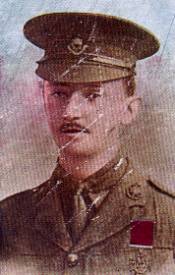|
Eric Archibald McNair
Eric Archibald McNair VC (16 June 1894 – 12 August 1918) was a British soldier. He was a recipient of the Victoria Cross, the highest and most prestigious award for gallantry in the face of the enemy that can be awarded to British and Commonwealth forces. BiographyHe was educated at Charterhouse School from 1907 to 1913, where he was Head of the School. He then went to Magdalen College, Oxford to study classics, though he left his studies shortly after matriculating to join the forces. While at Oxford he joined the Apollo University Lodge. He was 21 years old, and a Temporary Lieutenant in the 9th (Service) Battalion, Royal Sussex Regiment, British Army during the First World War when the following deed took place for which he was awarded the VC.
He later achieved the rank of Captain. He died of chronic dysentery at the base hospital in Genoa, Italy, on 12 August 1918.[2] His Victoria Cross is displayed at the Eastbourne Redoubt Museum, Eastbourne, Sussex, England. References
External links |
||||||||||||||||||||||
